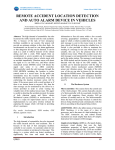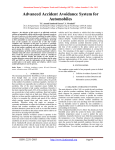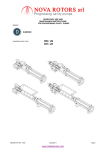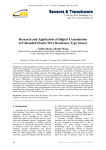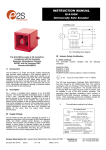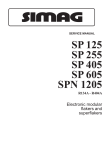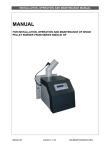Download Automatic Detection of Vehicle Accidents and Theft
Transcript
INTERNATIONAL JOURNAL OF PROFESSIONAL ENGINEERING STUDIES Volume I/Issue 2/DEC 2013 Automatic Detection of Vehicle Accidents and Theft Identification T.Mrudula 1, V.V.G.S.Rajendra Prasad 2 1 M.Tech Student, Dept of ECE, Nova College of Engineering & Technology for Women, Jupudi village, Ibrahimpatnam mandal, Krishna Dist, A.P, India 2 Professor & HOD, Dept of ECE, Nova College of Engineering & Technology for Women, Jupudi village, Ibrahimpatnam mandal, Krishna Dist, A.P, India Abstract: The high demand of automobiles has also increased the traffic hazards and the road accidents. This is because of the lack of best emergency facilities available in our country. Our project will provide an optimum solution to this draw back. An accelerometer can be used in a car alarm application so that dangerous driving can be detected. It can be used as a crash or rollover detector of the vehicle during and after a crash. With signals from an accelerometer, a severe accident can be recognized. According to this project when a vehicle meets with an accident immediately Vibration sensor will detect the signal or if a car rolls over, and Micro electro mechanical system (MEMS) sensor will detects the signal and sends it to ARM controller. Microcontroller sends the alert message through the GSM MODEM including the location to police control room or a rescue team. So the police can immediately trace the location through the GPS MODEM, after receiving the information. Then after conforming the location necessary action will be taken. This paper is useful in detecting the accident precisely by means of Micro electro Mechanical system (MEMS) or accelerometer. As there is a scope for improvement and as a future implementation we can add a wireless webcam for capturing the images which will help in providing driver`s assistance. Keywords: Accelerometer, GSM modem, GPS Module, Ignition switch. I. Introduction The high demand of automobiles has also increased the traffic hazards and the road accidents. This is because of the lack of best emergency facilities available in our country. An automatic accident detection device for vehicle accidents is introduced in this paper. This design is a system which can detect accidents in significantly less time and sends the IJPRES basic information to first aid center within a few seconds covering geographical coordinates, the time and angle in which a vehicle accident had occurred. This alert message is sent to the rescue team in a short time, which will help in saving the valuable lives. When the accident occurs the alert message is sent automatically to the rescue team and to the police station. The message is sent through the GSM module and the location of the accident is detected with the help of the GPS module. The accident can be detected precisely with the help of Micro electro mechanical system (MEMS) sensor. This application provides the optimum solution to poor emergency facilities provided to the roads accidents in the most feasible way. II. The Hardware System Micro controller: This section forms the control unit of the whole project. This section basically consists of a Microcontroller with its associated circuitry like Crystal with capacitors, Reset circuitry, Pull up resistors (if needed) and so on. The Microcontroller forms the heart of the project because it controls the devices being interfaced and communicates with the devices according to the program being written. ARM7TDMI: ARM is the abbreviation of Advanced RISC Machines, it is the name of a class of processors, and is the name of a kind technology too. The RISC instruction set, and related decode mechanism are much simpler than those of Complex Instruction Set Computer (CISC) designs. Liquid-crystal display (LCD) is a flat panel display, electronic visual display that uses the light modulation properties of liquid crystals. Liquid crystals do not emit light directly. LCDs are available to display arbitrary images or fixed images which can be displayed or hidden, such as preset words, digits, 65 INTERNATIONAL JOURNAL OF PROFESSIONAL ENGINEERING STUDIES and 7-segment displays as in a digital clock. They use the same basic technology, except that arbitrary images are made up of a large number of small pixels, while other displays have larger elements. Keys Section: With the help of these keys the users can enroll their eye images or will enter their passwords. Ignition Switch: The term ignition switch is often used interchangeably to refer to two very different parts: the lock cylinder into which the key is inserted, and the electronic switch that sits just behind the lock cylinder. In some cars, these two parts are combined into one unit, but in other cars they remain separate. Accelerometer: Micro-Electro-Mechanical Systems, or MEMS, is a technology that in its most general form can be defined as miniaturized mechanical and electro-mechanical elements (i.e., devices and structures) that are made using the techniques of micro fabrication. Volume I/Issue 2/DEC 2013 vehicle, Accident of a vehicle is identified by using a sensor and the information will be sent to the GSM modem. In this section we are using an H-bridge circuit to drive the motor. Power supply LCD GPS Micro Controller Ignitio n key GSM Modem (LPC2148) Keypad MEMS Acceleromet er Motor Fig.1.Block diagram of proposed system GSM Modem: GSM/GPRS RS232 Modem from rhydo LABZ is built with sim com Make SIM900 Quad-band GSM/GPRS engine, works on frequencies 850 MHz, 900 MHz, 1800 MHz and 1900 MHz It is very compact in size and easy to use as plug in GSM Modem. GPS: The Global Positioning System (GPS) is a satellite-based navigation system that sends and receives radio signals. A GPS receiver acquires these signals and provides you with information. Using GPS technology, you can determine location, velocity, and time, 24 hours a day, in any weather conditions anywhere in the world—for free. III. Design of Proposed Hardware System The process of working of this project is explained as follows, this total equipment of this project is placed in a vehicle. The authorized person details with mobile number and some predefined parameters are stored in the Microcontroller. Whenever we find that our vehicle is missing we can simply send a SMS or give a Missed-Call to GSM Modem from the authorized mobile to block the vehicle such that the vehicle will not move forward anymore. Then the Microcontroller gets the location of vehicle by the GPS modem and sends the message to the same mobile using GSM modem. The message includes the location at which the vehicle is present at that particular instant of time. And after vehicle gets blocked it will move further only when password was given to the system. Whenever any vehicle hits our IJPRES IV. Board Hardware Resources Features GSM Module GSM (Global System for Mobile communication) is a digital mobile telephone system that is widely used in many parts of the world. The mobile communications has become one of the driving forces of the digital revolution. Every day, millions of people are making phone calls by pressing a few buttons. Little is known about how one person's voice reaches the other person's phone that is thousands of miles away. Even less is known about the security measures and protection behind the system. The complexity of the cell phone is increasing as people begin sending text messages and digital pictures to their friends and family. The cell phone is slowly turning into a handheld computer. All the features and advancements in cell phone technology require a backbone to support it. The system has to provide security and the capability for growth to accommodate future enhancements. General System for Mobile Communications, GSM, is one of the many solutions out there. GSM has been dubbed the "Wireless Revolution" and it doesn't take much to realize why GSM provides a secure and confidential method of communication. GSM (Global System for Mobile communication) is a digital mobile telephone system that is widely used in many parts of the world. GSM uses a variation of Time Division Multiple Access (TDMA) and is the 66 INTERNATIONAL JOURNAL OF PROFESSIONAL ENGINEERING STUDIES most widely used of the three digital wireless telephone technologies (TDMA, GSM, and CDMA). GSM digitizes and compresses data, then sends it down a channel with two other streams of user data, each in its own time slot. GSM operates in the 900MHz, 1800MHz, or 1900 MHz frequency bands. GSM has been the backbone of the phenomenal success in mobile telecoms over the last decade. Now, at the dawn of the era of true broadband services, GSM continues to evolve to meet new demands. One of GSM's great strengths is its international roaming capability, giving consumers a seamless service. This has been a vital driver in growth, with around 300 million. In the Americas, today's 7 million subscribers are set to grow rapidly, with market potential of 500 million in population, due to the introduction of GSM 800, which allows operators using the 800 MHz band to have access to GSM technology too. GSM together with other technologies is part of an evolution of wireless mobile telecommunication that includes High-Speed Circuit-Switched Data (HCSD), General Packet Radio System (GPRS), Enhanced Data GSM Environment (EDGE), and Universal Mobile Telecommunications Service (UMTS). GSM security issues such as theft of service, privacy, and legal interception continue to raise significant interest in the GSM community. The purpose of this portal is to raise awareness of these issues with GSM security. The mobile communications has become one of the driving forces of the digital revolution. Every day, millions of people are making phone calls by pressing a few buttons. Little is known about how one person's voice reaches the other person's phone that is thousands of miles away. Even less is known about the security measures and protection behind the system. The complexity of the cell phone is increasing as people begin sending text messages and digital pictures to their friends and family. The cell phone is slowly turning into a handheld computer. All the features and advancements in cell phone technology require a backbone to support it. The system has to provide security and the capability for growth to accommodate future enhancements. General System for Mobile Communications, GSM, is one of the many solutions out there. GSM has been dubbed the "Wireless Revolution" and it doesn't take much to realize why GSM provides a secure and confidential method of communication. MEMS: Micro-Electro-Mechanical Systems (MEMS) is the integration of mechanical elements, sensors, actuators, and electronics on a common silicon substrate through micro fabrication technology. While the electronics are fabricated using IJPRES Volume I/Issue 2/DEC 2013 integrated circuit (IC) process sequences (e.g., CMOS, Bipolar, or BICMOS processes), the micromechanical components are fabricated using compatible "micromachining" processes that selectively etch away parts of the silicon wafer or add new structural layers to form the mechanical and electromechanical devices. MEMS promises to revolutionize nearly every product category by bringing together silicon-based microelectronics with micromachining technology, making possible the realization of complete systems-on-a-chip. MEMS is an enabling technology allowing the development of smart products, augmenting the computational ability of microelectronics with the perception and control capabilities of micro sensors and micro actuators and expanding the space of possible designs and applications. Fig.2. General Architecture of a GSM network The critical physical dimensions of MEMS devices can vary from well below one micron on the lower end of the dimensional spectrum, all the way to several millimeters. Likewise, the types of MEMS devices can vary from relatively simple structures having no moving elements, to extremely complex electromechanical systems with multiple moving elements under the control of integrated microelectronics. The one main criterion of MEMS is that there are at least some elements having some sort of mechanical functionality whether or not these elements can move. The term used to define MEMS varies in different parts of the world. In the United States they are predominantly called MEMS, while in some other parts of the world they are called “Microsystems Technology” or “micro machined devices”. While the functional elements of MEMS are miniaturized structures, sensors, actuators, and microelectronics, the most notable (and perhaps most interesting) elements are the micro sensors and micro 67 INTERNATIONAL JOURNAL OF PROFESSIONAL ENGINEERING STUDIES actuators. Micro sensors and micro actuators are appropriately categorized as “transducers”, which are defined as devices that convert energy from one form to another. In the case of micro sensors, the device typically converts a measured mechanical signal into an electrical signal. Over the past several decades MEMS researchers and developers have demonstrated an extremely large number of micro sensors for almost every possible sensing modality including temperature, pressure, inertial forces, chemical species, magnetic fields, radiation, etc. Remarkably, many of these micro machined sensors have demonstrated performances exceeding those of their macro scale counterparts. Volume I/Issue 2/DEC 2013 as many others. Surprisingly, even though these micro actuators are extremely small, they frequently can cause effects at the macro scale level; that is, these tiny actuators can perform mechanical feats far larger than their size would imply. For example, researchers have placed small micro actuators on the leading edge of airfoils of an aircraft and have been able to steer the aircraft using only these microminiaturized devices. Fig.4. A surface micro machined electro-statically-actuated micro motor fabricated by the MNX. This device is an example of a MEMS-based micro actuator. GPS Fig.3.Components of MEMS That is, the micro machined version of, for example, a pressure transducer, usually outperforms a pressure sensor made using the most precise macro scale level machining techniques. Not only is the performance of MEMS devices exceptional, but their method of production leverages the same batch fabrication techniques used in the integrated circuit industry – which can translate into low per-device production costs, as well as many other benefits. Consequently, it is possible to not only achieve stellar device performance, but to do so at a relatively low cost level. Not surprisingly, silicon based discrete micro sensors were quickly commercially exploited and the markets for these devices continue to grow at a rapid rate. More recently, the MEMS research and development community has demonstrated a number of micro actuators including: micro valves for control of gas and liquid flows; optical switches and mirrors to redirect or modulate light beams; independently controlled micro mirror arrays for displays, micro resonators for a number of different applications, micro pumps to develop positive fluid pressures, micro flaps to modulate airstreams on airfoils, as well IJPRES Global Positioning System (GPS) technology is changing the way we work and play. You can use GPS technology when you are driving, flying, fishing, sailing, hiking, running, biking, working, or exploring. With a GPS receiver, you have an amazing amount of information at your fingertips. Here are just a few examples of how you can use GPS technology. Know precisely how far you have run and at what pace while tracking your path so you can find your way home. Pinpoint the perfect fishing spot on the water and easily relocate it. Get the closest location of your favorite restaurant when you are out-of-town. Find the nearest airport or identify the type of airspace in which you are flying What is GPS? The Global Positioning System (GPS) is a satellitebased navigation system that sends and receives radio signals. A GPS receiver acquires these signals and 68 INTERNATIONAL JOURNAL OF PROFESSIONAL ENGINEERING STUDIES provides you with information. Using GPS technology, you can determine location, velocity, and time, 24 hours a day, in any weather conditions anywhere in the world—for free. GPS, formally known as the NAVSTAR (Navigation Satellite Timing and Ranging). Global Positioning System originally was developed for the military. Because of its popular navigation capabilities and because you can access GPS technology using small, inexpensive equipment, the government made the system available for civilian use. The USA owns GPS technology and the Department of Defense maintains it. Volume I/Issue 2/DEC 2013 when the satellite is in the earth’s shadow, satellites use backup batteries to continue running. Each GPS satellite is built to last about 10 years. The Department of Defense monitors and the satellites to ensure that GPS technology continues to run smoothly for years to come. GPS technology requires the following three segments. Space segment. Control segment. User segment Space Segment At least 24 GPS satellites orbit the earth twice a day in a specific pattern. They travel at approximately 7,000 miles per hour about 12,000 miles above the earth’s surface. These satellites are spaced so that a GPS receiver anywhere in the world can receive signals from at least four of them. Each GPS satellite constantly sends coded radio signals (pseudorandom code) to the earth. These GPS satellite signals contain the following information. The particular satellite that is sending the information. Where that satellite should be at any given time (the precise location of the satellite is. called ephemeris data). Whether or not the satellite is working properly. The date and time that the satellite sent the signal. The signals can pass through clouds, glass, and plastic. Most solid objects such as buildings attenuate (decrease the power of) the signals. The signals cannot pass through objects that contain a lot of metal or objects that contain water (such as underwater locations). The GPS satellites are powered by solar energy. If solar energy is unavailable, for example, IJPRES Fig.5.GPS Modem Control Segment The control segment is responsible for constantly monitoring satellite health, signal integrity, and orbital configuration from the ground control segment includes the following sections: Master control station Monitor stations Ground antennas Monitor Stations At least six unmanned monitor stations are located around the world. Each station constantly monitors and receives information from the GPS satellites and then sends the orbital and clock information to the master control station (MCS). Master Control Station (MCS) The MCS is located near Colorado Springs in Colorado. The MCS constantly receives GPS satellite orbital and clock information from monitor stations. The controllers in the MCS make precise corrections to the data as necessary, and send the information (known as ephemeris data) to the GPS satellites using the ground antennas. Ground Antennas Ground antennas receive the corrected orbital and clock information from the MCS, and then send the corrected information to the appropriate satellites. 69 INTERNATIONAL JOURNAL OF PROFESSIONAL ENGINEERING STUDIES User Segment The GPS user segment consists of your GPS receiver. Your receiver collects and processes signals from the GPS satellites that are in view and then uses that information to determine and display your location, speed, time, and so forth. Your GPS receiver does not transmit any information back to the satellites. Ignition switch The term ignition switch is often used interchangeably to refer to two very different parts: the lock cylinder into which the key is inserted, and the electronic switch that sits just behind the lock cylinder. In some cars, these two parts are combined into one unit, but in other cars they remain separate. It is advisable to check your car's shop manual before attempting to purchase an ignition switch, to ensure that you buy the correct part. In order to start a car, the engine must be turning. Therefore, in the days before ignition switches, car engines had to be turned with a crank on the front of the car in order to start them. The starter performs this same operation by turning the engine's flywheel, a large, flat disc with teeth on the outer edge. The starter has a gear that engages these teeth when it is powered, rapidly and briefly turning the flywheel, and thus the engine. The ignition switch generally has four positions: off, accessories, on, and start. Some cars have two off positions, off and lock; one turns off the car, and the other allows the key to be removed from the ignition. When the key is turned to the accessories position, certain accessories, such as the radio, are powered; however, accessories that use too much battery power, such as window motors, remain off in order to prevent the car's battery from being drained. The accessories position uses the least amount of battery power when the engine is not running, which is why drive-in movie theaters recommend that the car be left in the accessories mode during the movie. The on position turns on all of the car's systems, including systems such as the fuel pump, because this is the position the ignition switch remains in while the car's engine is running. The start position is spring loaded so that the ignition switch will not remain there when the key is released. When the key is inserted into the ignition switch lock cylinder and turned to the start position, the starter engages; when the key is released, it returns to the on position, cutting power to the starter. This is because the engine runs at speeds that the starter cannot match, IJPRES Volume I/Issue 2/DEC 2013 meaning that the starter gear must be retracted once the engine is running on its own. Either the ignition switch or the lock cylinder may fail in a car, but both circumstances have very different symptoms. When the ignition switch fails, generally the electrical wiring or the plastic housing develops problems. The car may not turn on and/or start when this happens. Also, the spring-loaded start position could malfunction, in which case the starter will not engage unless the key is manually turned back to the on position. When the lock cylinder malfunctions, however, the operation of the key itself will become problematic. If the tumblers become stripped, the lock cylinder may be able to turn with any key, or you may be able to remove the key when the car is on. If the tumblers begin to shift, the lock cylinder may not turn. Sometimes the key can be wiggled until the lock cylinder turns, but it is important to remember that this is only a temporary fix V. CONCLUSION With the advent of science and technology in every walk of life the importance of vehicle safety has increased and the main priority is being given to reduce the alarming time when an accident occur, so that the wounded lives can be attended in lesser time by the rescue team. This paper provides the design which has the advantages of low cost, portability, small size and easy expansibility. The platform of the system is ARM along with MEMS, GPS and GSM, interfacing to locate the site of accident accurately. This system can overcome the problems of lack of automated system for accident location detection. Consequently, the time for searching the location is reduced and the person can be treated as soon as possible which will save many lives. This system will have broad application prospects as it integrates the positioning systems and the network of medical based services. The accident can be detected by MEMS sensor which will give the accurate information. The controller will process the data, as soon as input is received by the controller and message is sent through the GSM module. The geographical coordinates and the time of the site of the accident is detected by the GPS module. An alternate condition is given by pressing a switch, in order to interrupt the flow of sending the message in case of no casualty; this will help to save time of medical rescue team and unnecessary alarming which creates havoc in such unusual conditions. The accident location automatic detection will help us to provide security to the vehicles and to the lives of the people. The high priority is given to the lives of the 70 INTERNATIONAL JOURNAL OF PROFESSIONAL ENGINEERING STUDIES Volume I/Issue 2/DEC 2013 people. Hence, this paper provides a feasible solution to traffic hazards and it gives security to vehicle and reduces loss of valuable lives and property. Affiliated to Jawaharlal Nehru Technological University, Kakinada, and is approved by AICTE Delhi. REFERENCES V.V.G.S.RAJENDRA PRASAD, his Qualification is M.tech, MISTE currently working as Professor & HOD, in the Department of Electronics and communication Engineering, Nova College of Engineering & Technology for Women, Jupudi village, Ibrahimpatnam mandal, Krishna Dist, A.P, India. Affiliated to Jawaharlal Nehru Technological University, Kakinada, and is approved by AICTE Delhi. [1] Yao Jin. The discussion of Road Traffic Safety Countermeasures System[J]. Private Science and Technology, 2010. [2] Wang Wei. Embedded Microcontroller MC9S08AW60 Principles and Application [M]. Beijing: Beijing Aerospace University Press, 2008. [3] Zhu Yi, Yang Shubo. MMA series of acceleration sensor principles and application [J]. Medical equipment, 2008. [4] TAYLORRK, SCHROCKMD, BLOOMFIELDJ, Dynamic testing of GPS receivers [J]. Transactions of the ASAE, 2004,47 (4). [5] SIEMENS, TC35i Hardware Description [M]. April 14,2003 Interface [6] Ma Chao. Embedded GSM message interface hardware and software design [J]. Microcontroller and Embedded Systems, 2003, [7] Wang Wei and Fan Hanbo, Traffic accident automatic detection and remote alarm device, IEEE proc.ICEICE pp-910-913, April 2011. [8] Raj Kamal, EMBEDDED SYSTEMS achitecture,programming and design, Second Edition, TATA McGraw-Hill publishing Company Limited, 2008. [9] Steve Furber, ARM SYSTEM-ON-CHIP ARCHITECTURE, SECOND EDITION, Pearson Education Limited, 2000. [10] GSM User Manual, SIMCOM LTD, August 2006. [11] Arm User Manual, Phillips, August 2005. [12] MEMS User Manual, Semiconductors, 2009. Free scale [13] GPS Beginner`s Guide, Garmin LTD, 2008. T.MRUDULA, pursuing her M.tech in Embedded Systems from Nova College of Engineering & Technology for Women, Jupudi villaga, Ibrahimpatnam mandal, Krishna Dist, A.P, India. IJPRES 71







